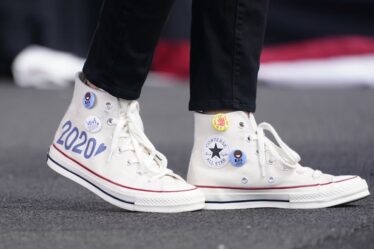
OXFORDSHIRE, United Kingdom — The true significance of any innovation is only clear in hindsight, but generative artificial intelligence is shaping up to be possibly the most important technological advance since the birth of the internet. At BoF VOICES 2023, speakers from LVMH chief data officer Anca Marola to musician Ali Sethi discussed the capabilities this powerful new form of AI offers to creatives, companies and people more broadly. Fashion is paying close attention. Some 73 percent of executives expect to prioritise the technology next year, according to “The State of Fashion: 2024″ by BoF and McKinsey.
The author has shared a YouTube video.You will need to accept and consent to the use of cookies and similar technologies by our third-party partners (including: YouTube, Instagram or Twitter), in order to view embedded content in this article and others you may visit in future.
Augmenting Creativity
LVMH’s Marola kicked off the session talking about her experience of 10 years at the luxury giant.
“The first and most important learning is that it’s not about technology,” she said.
What matters is the abilities technology enables, such as enhancing the customer experience by empowering store associates with predictive analytics that let them know which customers to speak to and which products they might be interested in. She’s noticed any time you apply machine learning to a process, it tends to yield at least 30 percent improvement.
The company is now looking at generative AI and how it can use it for everything from customer service to aiding in product development. In Marola’s view, it will likely never replace a human designer, but it can make the process more efficient by speeding up prototyping. Designers at LVMH are experimenting with the technology to spark ideas and iterate on them.
Interior designer Kelly Wearstler and artist Andrés Reisinger spoke about how they have similarly used generative AI as a way to blend references into novel configurations, such as using an item of furniture as the jumping off point for a set design. The AI doesn’t produce the final product, and their creativity and taste are still vital. But it helps them to dream up and visualise their ideas faster than they could otherwise.
“If you’re running a business, you only have a finite time to be creative,” Wearstler said. “If this is really affording us more options, then we’re going to produce better results.”
In a talk that blended in musical performance, Sethi described his own use of AI for blending genres of music to conceive new ideas. Last week, he said, he used a new tool introduced to him by a producer to combine raga and qawwali — two traditional musical frameworks in India and Pakistan — with Spanish flamenco and Caribbean reggaeton. The resulting song, he said, will be the basis of his next creation.
Marketing Magic
One of the greatest challenges for brands today is understanding whether the marketing they laboriously craft and disseminate to the world is having the effect they intend. To help, BoF partnered with the insights firm Quilt.ai earlier this year on BoF’s inaugural Brand Magic Index. On stage, Quilt’s founder and chief executive Anurag Banerjee joined BoF’s Rahul Malik, to explain how the index uses AI to measure the alignment between how a brand sees itself and how its customers see it. By analysing large amounts of data posted by both the brand and its customers online, the index is able to essentially measure the distance between how a brand wants to be perceived and how it’s actually perceived.
“When you say something and you are understood, there is fit, there is harmony, there is music, and we believe there is magic,” Banerjee said.
It’s only one example of the impact AI is able to have on marketing. Rachel Higham, chief information officer of WPP, an advertising and transformation company, spoke with Microsoft global director Mariam Chahin about how WPP is using AI on campaigns. In one example, it expanded the frame around Johannes Vermeer’s painting “The Milkmaid” for a project it did for Nestlé, whose most popular yogurt in France shares its name with the artwork. Higham also shared her thoughts on how to prompt AI tools to get the best results. The text typically needs to be very detailed, and the user has to understand they’re working with the machine in an iterative process.
“You have to be very forgiving, and you have to see it as a true partnership,” she said.
For the Betterment of Humanity
Experts have been warning loudly that AI carries very real risks if left to advance unchecked, but the technology also promises benefits if harnessed thoughtfully.
Manu Chopra, CEO and co-founder of Karya, described how the organisation is using it to uplift people in rural India. When a company such as Microsoft wants to build a computational language model in an Indian language such as Marathi, Karya can break that into smaller microtasks such as having native speakers read out simple sentences and offer it to people on their smartphones. For that work, which is crucial to Microsoft, it’s able to pay 20 times India’s living wage, Chopra said, allowing workers to escape poverty.
Chopra added that other organisations are using AI for other beneficial purposes. If technology is driven purely by the market and disregards social inequities, the result will be amazing innovations that leave the world only more divided, he warned.
Aza Raskin, who also spoke in the first session of VOICES 2023, took the stage to talk about his work trying to bridge a very different divide with his non-profit Earth Species Project. Its hope is to use AI to allow humans to understand the languages of animals that researchers have found communicate sonically such as whales, dolphins and birds.
“The world is awash in meaning. We’re just unable to perceive it,” Raskin said.
The same techniques allowing large language models to understand the relationships between words and power tools like ChatGPT can also be used to decode the sounds animals make, according to Raskin. The goal isn’t just to communicate with animals but potentially to change humans’ relationships with animals, and ideally, to learn from them. Raskin said he wasn’t certain which fascinated him more: The parts of animal communication we can potentially translate directly into human language, or those parts we can’t.
BoF VOICES 2023 is made possible in part by our partners Snapchat, McKinsey & Company, Porsche, Getty Images, Invisible Collection and Soho House.
LVMH is part of a group of investors who, together, hold a minority interest in The Business of Fashion. All investors have signed shareholders’ documentation guaranteeing BoF’s complete editorial independence.



